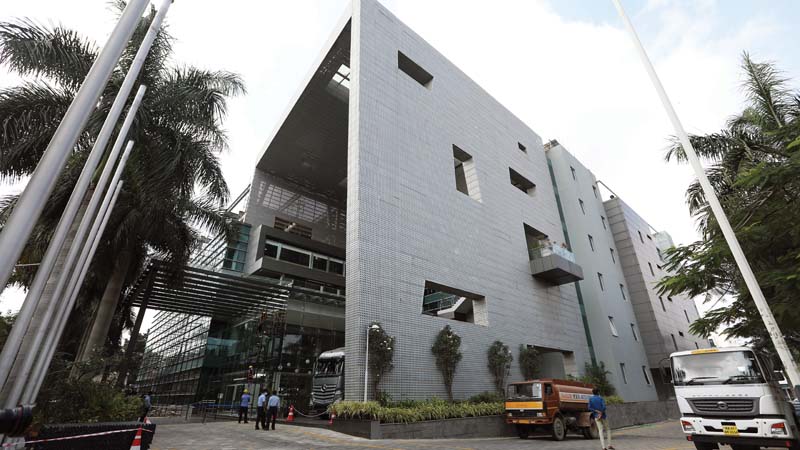Daimler Truck Innovation Center India has commenced operations. Ashish Bhatia looks into the largest Daimler Truck AG centre outside Germany, acting on crucial fronts of mobility.
Daimler Truck Innovation Center India (DTIC) in Bengaluru has commenced operations. It is the most significant innovation and development centre outside Germany for Daimler Truck AG as a captive unit with ~1300 skilled engineers. Focused on crucial aspects of mobility like safety technology and innovation, the centre will act as the hub of research, product engineering, innovation and Information Technology (IT). The standalone entity in India, according to Raghavendra Vaidya, Managing Director and Chief Executive Officer, DTICI is vital to the future engineering and design roadmap at the Original Equipment Manufacturer (OEM). Addressing the needs of its domestic and global regions of interest, the centre, he pointed out, is well equipped with state-of-the-art technologies and tools. It will act upon innovative research projects to help align with the crucial fronts of mobility. It comes as a critical development post-Daimler AG spun off its trucks business from Mercedes-Benz cars. The two-vehicle businesses were quite distinct, with different customers, technologies and financial requirements calling upon the need for a dedicated centre for innovation.
According to Vaidya, DTICI is aligned with Daimler Truck, its ambition and its strategy globally, as it entered into a phase of complete disruption in the automotive industry. “The need for alternate powertrains and software-led innovation in the commercial vehicle industry is going to define the future of commercial vehicles,” he opined. Drawing attention to the significant engineering presence in India by way of the erstwhile setup, the decision to split the entire Daimler Group into two companies gave rise to the need for a standalone, deep engineering and technical expertise. It was thought of as a way to realise ambitions of going towards zero-emission vehicles with either battery or hydrogen-based fuel cells.
DTICI is driven by the goal to lead the industry in software-led innovations. To attain it, Daimler decided to up the ante from being an engineering centre to evolving as an innovation centre, shared Vaidya. With India ticking all boxes, from the perspective of talent, ability and reach that the OEM commands globally, the company zeroed in on Bengaluru for the commissioning of the new centre. Notably, the new centre is the only innovation centre that works across all the regions and brands of Daimler Trucks like North America, Europe, Asia, and China. On the capex outlay for the centre, he explained, that since it’s not manufacturing intensive, the company is instead invested in building capability and people skill sets.
Capabilities at DTICI
Most of the work done at DTICI is carried out in the digital format. The exceptions include some of the labs where it has in-house, hardware-in-loop testing or component test benches for the ECUs. In the case of product engineering capability, DTICI boasts capabilities across the board for engineering a commercial vehicle. Be it a truck or a bus, from mechanical engineering to electrical, electronics, and engineering. Electronics and software are a huge focus area. In effect, the centre is claimed to cover the entire gamut of engineering capabilities on the product engineering side. On the IT front, the centre covers the entire life cycle of engineering, after sales, and manufacturing. Beyond it, the centre also boasts of extremely deep expertise in advanced analytic and data science.
The investments in product engineering extend to software and electronics where Daimler is invested heavily, globally. Covering trucks for all their hardware and electronics, the capabilities are spread over five domains: software and electronics, HMI which is the head unit that the drivers interact with through connectivity and responsible for big data, and powertrain which controls the engines and makes the vehicle intelligent. Through body controls, it facilitates the interaction between intelligent tractors and trailers. Lastly, it also contributes to active safety and automation, which is the Advanced Driver Assistance System (ADAS) including extremely complex, software implementations like Active Brake Assist (ABA). Notably, of these, the vehicle connectivity domain is entirely owned and managed by India with global responsibility. It breaks away from the pack from the perspective of engineering centres vesting accountability to the headquarters.
With the division of Daimler Trucks and Mercedes-Benz cars division, the task was cut out. To reposition and re-establish the digital infrastructure. “A lot of the digital infrastructure that we were sharing with the passenger cars is all gone. So we’ll have to set up our own digital infrastructure in engineering and manufacturing, after sales and so on. So the team are extremely involved in those projects, where we reestablish our digital infrastructure,” he explained. With prognostic capabilities, the centre hopes to make the factories more efficient by purely harnessing the power of data and using advanced systems.
Finding solutions
At DTICI, the task is cut out; to answer complex questions with real-world solutions. Vaidya admitted to range prediction being a very complex problem, and one that nobody has solved. “All of us are trying to solve it and whoever is also the first will have a competitive advantage. So, there is a very fundamental problem-solving paradigm we are entering into, because of zero-emission and because of the advances in software and electronics,” he mentioned. Moving on to scientific problems, the centre will overlook battery chemistry or for example how to build hydrogen-based solutions with a 10-year forward outlook. With engineering centres spread across Stuttgart, Germany, and Portland, USA including an engineering team in Tokyo to go along with the comparatively smaller hubs, at DTICI, teams are well aware of allocating resources consciously and avoiding duplication of work. As a crucial part of an integrated engineering team, it is determined to hold its own and build the right manufacturing capabilities without continuous access to the product or the production facilities, like software, electronics, design and so on. DTICI will also partner closely with Indian suppliers for product development and IT collaborations.






















